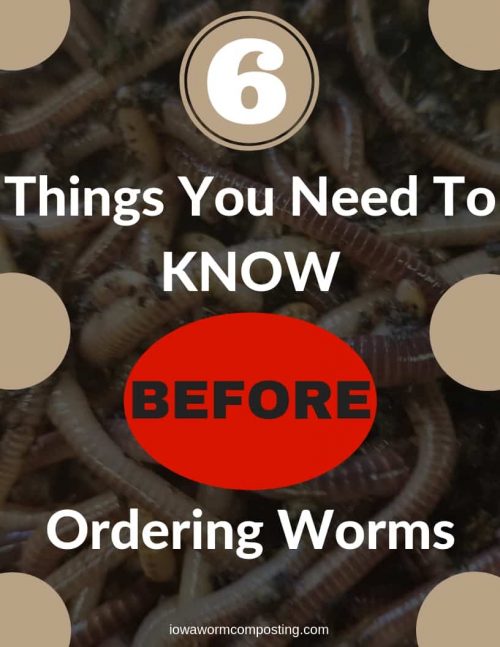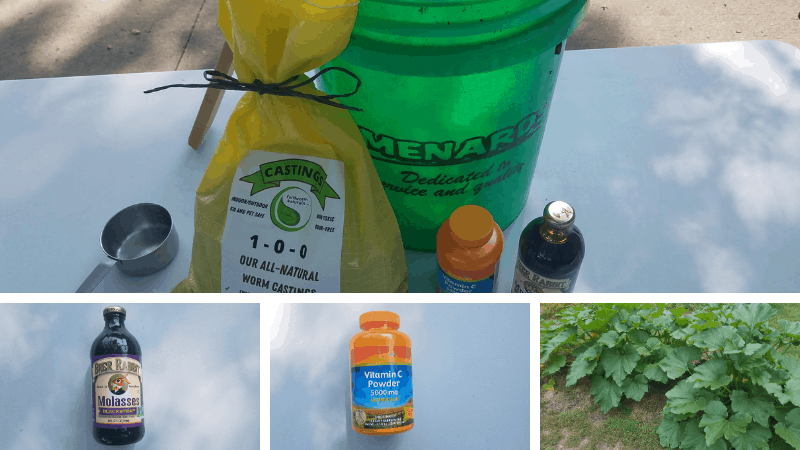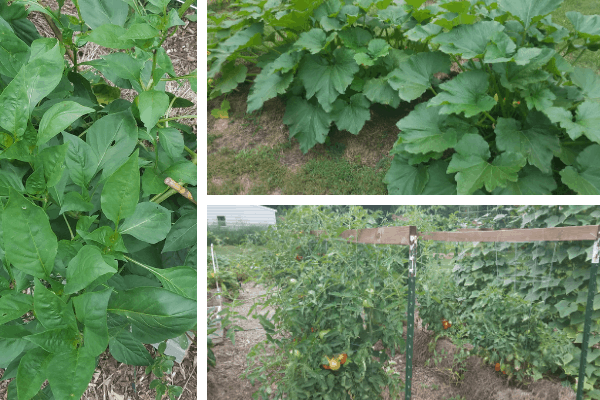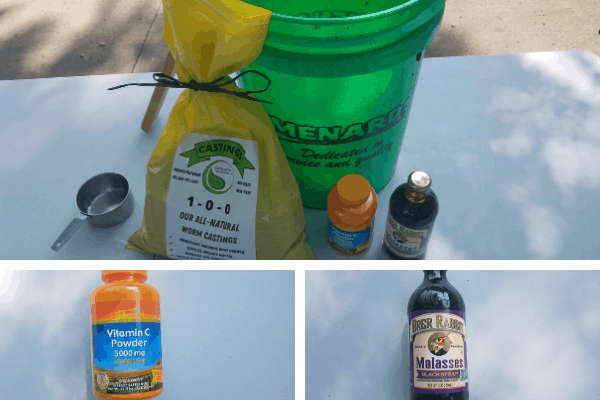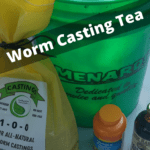Worm casting tea can save you big money. Worm castings work by adding bacteria, fungi, and other living organisms to your soil. What if we could use a small amount of worm castings and multiply those bacteria and organisms? Welcome to the world of worm casting tea and saving money. There are also many other benefits that we will discuss.
What is Worm Casting Tea?
Worm casting tea is made by adding worm castings to water and allowing them to steep for a certain amount of time. Generally, a food source is added along with the castings to help the bacteria and fungi reproduce and grow. Other organisms present in the worm castings will also increase in number. Worm tea becomes a natural fertilizer.
So, the benefit is that you can use a small amount of worm castings and enhance the biology, to improve your plant’s growth and your soil. This will save you money by stretching your castings dollar.
Two Types of Worm Tea
There are two basic types of worm teas.
- Steeped and stirred teas (Extraction)
- Actively aerated compost teas (AACT)
Let’s talk about the pros and cons of both types of worm teas.
Steeped and Stirred Worm Teas (Extraction)
This is exactly like it sounds. You add worm castings to de-chlorinated water and stir occasionally for a given amount of time. As a result, the bacteria and organisms will multiply over time and produce a liquid fertilizer you can apply. The tea can be applied as a foliar feeding, a root drench, or both.
Pros:
- There is no need for any expensive equipment. A container, water, and worm castings are all you need.
- Simple process. Start your batch and stir once in a while.
- Easy way to start and learn the basics.
Cons:
- Timing is important. You are not adding much oxygen and anaerobic bacteria can take over your brew.
- There will not be as much aerobic bacterial reproduction and numbers will not be as high.
Actively Aerated Compost Teas (AACT)
AACT is the gold standard of worm casting tea. A brewer mechanism and an air pump are used to increase the dissolved oxygen in the tea brew. The bacteria and other organisms feed on this oxygen. This process greatly increases the numbers and diversity of living organisms in your tea. As a result, this makes your casting tea more effective and you get the biggest bang for your buck. Think of it like driving a Chevy (steeped tea) or driving a Ferarri (AACT), for instance.
Pros:
- Aerobic bacteria and other organisms thrive and multiply faster because of the enhanced oxygen levels.
- The diversity of living organisms benefit your plants because they all have individual needs.
- Sheer numbers of organisms will also be much greater in an AACT.
- This is the most frugal use of those expensive worm castings and will save you the most money.
- Worm teas can be diluted with water after brewing and this allows you to stretch them even further when applying.
Cons:
- There is an investment upfront. A brewer and air pump are required but the cost can be as low as $100.
- You may need to purchase or make multiple brewers if you brew different batch sizes.
- A container is needed to brew your tea. This can be a 5 gal. bucket, garbage can, 55 gal. drum, or even larger.
We highly recommend making AACT, but if you are just starting out, steeped worm casting tea is certainly okay. However, we DO NOT endorse using the run-off from your worm bins. This is NOT worm tea. It is LEACHATE and very dangerous to use on any vegetables you may eat. For instance, leachate may contain e Coli, salmonella, or any number of bad anaerobic bacteria. If you have leachate, use it on your trees or landscapes, but not edible plants.
Top 10 Benefits of Worm Casting Tea
There are several benefits of making and using worm teas. Some of the major benefits are listed here:
- Aids in seed inoculation and germination.
- Adds microbial biomass to your soil.
- Helps to deter bugs and other pests.
- Suppresses many plant diseases.
- Breaks down thatch in your yard.
- Helps plants to grow larger, produce more, and stay healthier.
- Great compost starter if you have a thermophilic compost pile.
- You can use fewer nutrients for the same results in a hydroponic application.
- Immediate nutrients are available for your plants.
- Helps you save money by using fewer castings for the same result.
Worm tea is really almost a magical elixir for your garden, lawn, landscape, or houseplants. We have been making worm tea for years because we see the good results time after time.
How To Start Making Castings Tea
The first thing that you need for good worm casting tea is a quality worm casting. We recommend our Earthworm Naturals Worm Castings. We have tested these castings and can attest to the results. However, any good worm castings will make a fine worm tea.
Keep it simple at first and start with a steeped tea (extraction) in a 5-gallon bucket.
You are going to need unchlorinated or dechlorinated water. The chlorine is there to kill bacteria. We do not want that to happen. There are a few ways to deal with this problem. You can fill your bucket and let it sit uncovered for 24 hours. The chlorine will off-gas and your water will be ready to go. You can also use a chlorine filter.
One of the latest problems is that some cities have started using chloramines and they do not off-gas like regular chlorine. Here is the foolproof way to make your water suitable for worm tea. Add Vitamin C Powder (ascorbic acid) to your water. A 1/4 tsp. to 5 gallons of water will neutralize chlorine OR chloramines in 10 minutes. This is our go-to method. We use a 1/2 tsp. for a 25 gallon batch. A little goes a long way. Also, plants love Vitamin C, so if there is a little extra it won’t hurt anything.
A Simple Worm Casting Tea Recipe
Worm tea recipes don’t have to have a list of ingredients a mile long. Simple is usually best and yields good results. Here is one of our favorite worm tea recipes:
- 4 gallons dechlorinated water in a 5-gallon bucket
- 2 cups worm castings (we like Earthworm Naturals Brand)
- 2 TBSP. un-sulfured Blackstrap molasses
- 1 handful of Spaghnum peat moss (for fungi)
- 3 TBSP. Azomite (micronized)
Making Your Worm Tea
Throw all the ingredients in the bucket and give it a good stir. Put your bucket in the shade out of direct sunlight if possible. Try to stir it a least a couple of times a day. You can set a board on top or loosely cover. Steep for 48-72 hours. It should smell earthy.
If it starts to smell bad, you have let it steep too long. In that case, use the worm tea on your lawn, landscape, or trees. Do NOT put it in your garden.
When your tea is ready, filter it with a 5-gallon paint strainer bag (available at any hardware or big box store). DON”T throw the filter away because you can rinse, dry, and reuse it. Use the spent castings on your favorite tree or put them on your compost pile.
Here is a YouTube video that shows the process.
Application
The worm casting tea can be applied full-strength or diluted. We use an Ortho hose-end sprayer to apply the tea to our garden and landscape. We set it on 8 oz. per gallon and spray away. This works very well. Alternatively, you can apply with a watering can. Also, you can do a root drench, with just a cup full-strength if you want.
Worm tea can usually be sprayed with a trash pump (or similar) and a garden hose if you have that available.
Warning: Be careful using a pressure-type sprayer. The spray nozzles can sometimes damage the microbes and lessen the effectiveness of your tea. You almost have to check with a microscope to tell if your particular pressure sprayer will work okay with worm tea.
You really can’t use too much worm tea because it will never burn your plants. We try to apply it to our garden every couple of weeks or so. At least, apply once a month for good results. The same goes for your lawn. Once a month is a pretty good schedule because it will help to reduce thatch and keep your lawn healthy.
Conclusion
We have talked about worm casting tea and the many benefits of using it. Also, the 2 types of worm tea were discussed, and we recommended making AACT.
A simple recipe for worm casting tea was given and we recommended starting by making a steeped (extraction) tea. Instructions for making and applying the tea was also detailed.
A future blog post will include brewers, air pumps, and instructions for creating actively aerated worm casting tea (AACT). There is just too much information to fit into one post.
AACT’s are our favorite brews but a good first step is starting with the extraction method of making worm tea.
Go ahead and make some worm tea and apply it to your plants. You will be saving money and also building your soil microbiology. You too will become a believer in worm casting tea.

